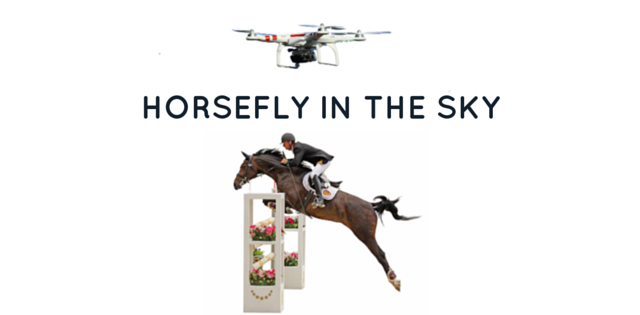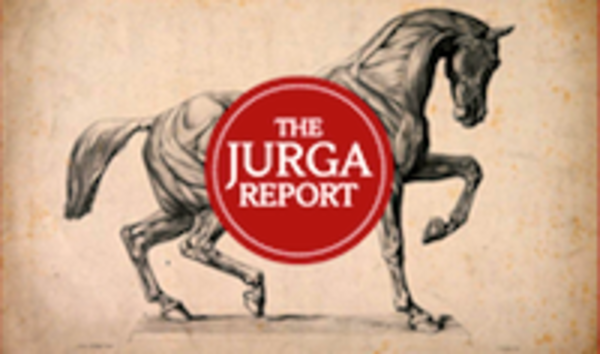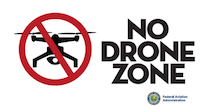Horse Fly in the Sky: Can Equestrians and Drones Co-Exist?
- March 10, 2017
- ⎯ Fran Jurga

Be sure to smile as you gallop across the field. Or trudge from your house to the barn. Unmanned aerial vehicles (“UAVs” or “drones”) are everywhere, whether you and your horse want them to be or not. Some horse owners and community officials are taking steps to protect their horses’ safety and the privacy of property owners. How are equestrians getting along with these giant horseflies in the sky?
If a tree falls in the forest and no one is around to hear it, does it still make a sound? If a drone is in the sky and a horse spooks, must the drone assume the fault?

Battle lines are being drawn between communities or individuals who want to protect horses (and other animals) and property from Unmanned Aerial Vehicles–UAVs, or “drones”. Drones are everywhere–including many places where they just don’t belong. Just ask the British Airways pilot who struck one in the landing path at London’s Heathrow Airport.
Drones are the latest technology to evoke simultaneous love/hate reactions in people. But for horse owners in particular, the pull is strong. A drone view of a horse galloping is wonderful; even a very very high drone-view of Nyquist galloping before the Preakness in May attracted thousands of views on YouTube when the Maryland Jockey Club released it.
To a horse, a drone may not be visible, but the sound of its motor is pitched at high whine, not unlike the buzz of an annoying horsefly set to deliver a painful bite. The closer it gets, or descends, the more likely the horse is to shy or rear.
That’s the theory behind an ordinance passed last week for horse-happy Mackinac Island in northern Michigan. The famous island is powered mostly by horses and drones are out of character on the offshore antique-themed vacation spot. However, it is not the technology that lawmakers find objectionable; it’s the effect that drones may have on horses that ferry tourists, collect the trash and provide all the basic services on the island. The new law goes into effect July 26.

Not only did the town officials cite the danger of horses being spooked by drones, they also mentioned that drones–or parts of drones–might fall from the sky and injure horses or humans.
But if you think the Irish showjumping team was robbed of its chance to compete at the Rio Olympics when a show official ran across Cian O’Connor’s track to the next obstacle last summer at the European Championship, consider how Austrian ski racer Marcel Hirscher felt when a drone crashed a few feet behind him during a high-speed slalom race: (watch video below)
The Kentucky Derby banned drones altogether in 2015, and continued with the ban this year. Last week, the British Horseracing Authority banned drones at racetracks in the United Kingdom, after jockey Frankie Dettori was unseated from his mount when it was allegedly spooked by the sound of a drone overhead at Newmarket’s July racecourse. The horse reared and crashed into the rail. In that case, the drone was doing its job: filming the race below, just as it had for the previous 14 months it was in use.
“We have made the decision to suspend using the drone on all British racecourses until the incident has been properly assessed,” the Authority said. “Welfare of horse and rider must always come first.”
British regulations require the drone to be at the side or behind the horses during a race; a drone may not fly over people, so the finish of a race is often not shown on drone footage.
It’s not all high-tech fun and games. Just ask the caretakers of Fimber, the British police horse found dead in his field after crashing into a post. Closed-circuit video revealed that he was spooked by an uninvited drone. Since then, a private drone operator in the UK was the first convicted of illegal use of drones, including harassing horses in their fields, after he posted his drone videos on YouTube.
This Louisiana couple rescued two horses, only to have both break through their fence, on different days, and require veterinary care. This news report traces their horses’ injuries to a malicious drone in their neighborhood:
If a drone operator is found guilty of illegal drone use, or invasion of privacy, what then? Most of the charges are misdemeanors.
On June 21, the Department of Transportation’s Federal Aviation Administration announced new regulations for small drone (or UAS, Unmanned Aerial Systems, in government documents) use in the United States. Non-hobbyist drones under 55 pounds will operate under regulations that require pilots to keep an unmanned aircraft within visual line of sight. Operations are allowed during daylight and during twilight if the drone has anti-collision lights. The new regulations also address height and speed restrictions and other operational limits, such as prohibiting flights over unprotected people on the ground who aren’t directly participating in the UAS operation. Finally, the person actually flying a drone must be at least 16 years old and have a remote pilot certificate with a small UAS rating, or be directly supervised by someone with such a certificate.
This YouTube video of panicked horses is accompanied by an explanation that “”The horses were not really spooked. They just like an excuse to run.” What do you think?
Stories of the interaction between horses and drones are achieving urban legend status. There’s the trainer who swears a drone came down and hovered two feet above a horse’s head. A rancher claims that a drone landed on the back of one of his bulls.
Most of us would believe the one about the mare (chestnut, no doubt) who wheeled and kicked a drone right out of the sky with her hind legs. But the gelding who was found at feed time with a drone snarled up in his tail? Retrieving that one is a job for some groom to tell around the RV fire pit for decades to come!
To understand drones, it’s important to know that the US government is the ultimate authority over them, since they use air space. A Supreme Court privacy decision back in 1946 settled a North Carolina chicken farmer’s complaint about lowflying military aircraft disturbing his hens and, by extension, his income from their eggs. The Court ruled that private citizens have the right to what goes on in 83 feet of vertical space above the property they own, and that ruling still stands.
The risks to horses from drones are not just limited to causing them to panic, or injuring them by falling out of the sky. The drones’ blades can stir up dust, and horse owners and riders may feel that their privacy is violated by drone observations.
Laws regarding nuisances and privacy invasion apply to drones, of course, but one of the burdens of making any charges is both proving that a drone did what you claim, showing actual damages caused by the drone footage, and actually finding out who owns the offending drone. Drone operators are required to obtain permits, but someone with malicious intent may not feel compelled to go on record. FAA rules include punishment with three years in prison for operating a drone without a permit. But who is around to check?
In California, a new law states that “A person is liable for physical invasion of privacy when the person knowingly enters onto the land or into the airspace above the land of another person without permission…in order to capture any type of visual image, sound recording, or other physical impression of the plaintiff.”
But isn’t that closing the barn door…after the horse is out–and maybe even dead?
How beautiful can drone footage of horses be? Consider this Swedish video of racehorses training on a winter’s day:
Should drones be at horse shows? The British Horse Society has a page of advice under its “Advice and Prevention” policies on how to deal with drones. Are drones the new thunderstorms?
Ledyard, Connecticut is one town that is concerned about drones interfering with horse shows; Ledyard has a large fair with a horse show each year. Del Mar Fairgrounds in California has banned drones altogether, as has the Minnesota State Fair. There’s a “no fly zone” over the Dublin Horse Show in Ireland this week. But a new phenomenon, drone racing, is gaining support and would like to be part of big events. Can horses and drone races co-exist at shows?
This video from the Blowing Rock Horse Show is lovely, and hopefully was filmed with permission:
But let’s have a reaction from the horses themselves. When a drone crashed in a horse paddock, these horses expressed their natural curiosity, gave a sniff…and then walked away:
Drones certainly have their place in the horse world. They can help mounted patrols extend their area during search-and-rescue missions. They have been suggested as replacements for helicopters to herd wild horses. They can observe horses in far fields, or from remote locations. CNN suggested last year–and illustrated–that drones are perfect for polo referee assistance.
If you ever need to sell a horse property, you will welcome a drone onto your land. The impressions created in drone videos are now de rigeur for higher-end realty marketing.
For some fun on YouTube, check videos of people on horseback who are operating drones at the same time. Is it the ultimate in self-coaching…or the epitome of selfie-style narcissism? Maybe a drone is cheaper than a trainer, if it tells you what you want to hear.
As the federal government straightens out what drone laws will mean to neighbors and private citizens who want to protect their animals and their privacy, the issue of protecting your horse from drones remains up in the air. Be armed with the facts and your rights if you see one coming, and find out how to use one responsibly and legally to capture your horses fro a new and stunningly beautiful angle.
To learn more:
U.S. Government (DOT and FAA) 2016 Rules for Small Unmanned Aircraft Systems
The Urban Equine’s Most Hazardous Duty: Police Horses in the Global War on Terror and Crime (The Jurga Report)
Mackinac Island restricts drone use (Detroit News)
Supreme Court decision, United States v. Causby
Drone, Drone on the Range (Modern Farmer)





